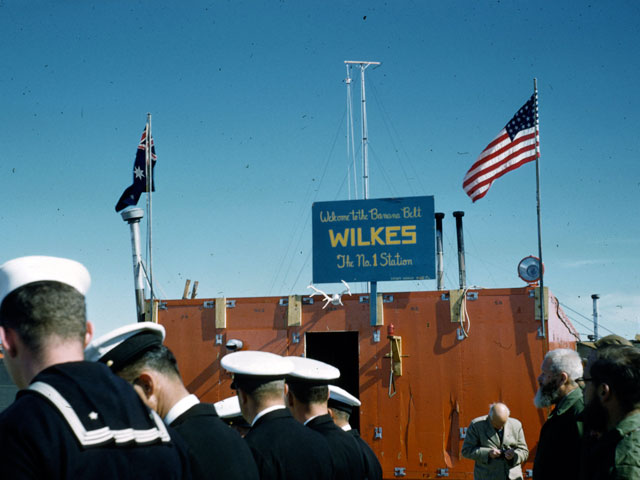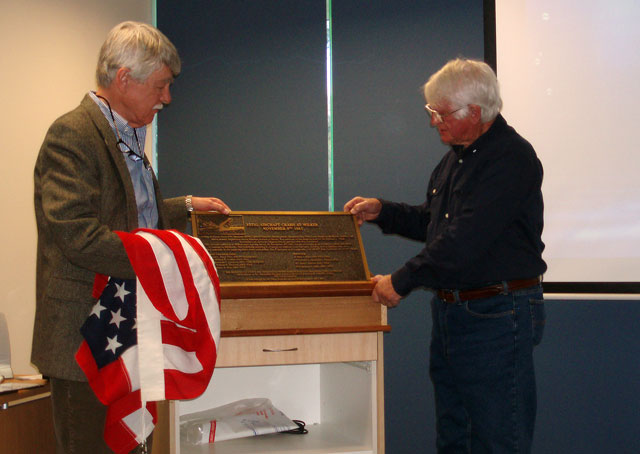Not forgottenNew Antarctic memorial immortalizes tragic plane crash from 50 years agoPosted May 11, 2012
Ernie Hand recalls the gasoline fireball filling the plane up to his ankles. He had managed to bring the U.S. Navy “While we were sliding, things were blowing up. There were a lot of hydraulic cylinders, oxygen bottles, that kind of stuff,” says Hand, the co-pilot that day more than 50 years ago. “When it came to a stop, I opened the escape hatch and rolled out. I was on fire from one end to the other,” he adds with a strong Southern drawl that makes the story sound so matter-of-fact. “A lot of things go through your mind: Shall I run and get away from this thing, because it kept blowing up. But I stopped and thought, ‘I better put myself out.’ So I did.” More on the Story
Hand, 75, somehow survived with three other men when their plane caught fire on Nov. 9, 1961, shortly after taking off from Wilkes Station on the coast of East Antarctica. Five others weren’t so lucky, including four members of the Navy’s VX-6 squadron and a U.S. scientist. Until recently, the incident was a fading memory, remembered by a handful of men who had witnessed the tragedy. Time was consuming the wreckage itself, as snow drifts buried the parts of the aircraft that had been left at the site. “Clearly, in [a] few years time, there’d be no trace of the tragedy visible, to serve as a stimulus for reflection on the event,” says Bill Burch. Burch had witnessed the accident from the ground. Also, as the station’s “official photographer,” he shot stills and video of the takeoff. Later, he would write an essay about the tragedy called “The All American Boy,” 
Photo Credit: Todor Iolovski/Australian Antarctic Division
Bill Burch revisits Wilkes Station in 2008.
“I felt it would be a loss to the history of the region if there was not some basic permanent record of this accident,” says Burch, 73, via email from Australia. Eventually, he joined forces with Billy-Ace Penguin Baker and the Old Antarctic Explorers Association (OAEA) Baker arranged for the OAEA board of directors to donate $1,000 toward a bronze plaque that would commemorate the crash. Burch and some of his Wilkes crewmates added another $300. On April 21, 2012, members of Australia’s Casey Station “Standing there, it certainly feels poignant and appropriate,” says Casey Station leader Mark Hunt, who helped arrange for the delivery of the plaque to the Ice and oversee the memorial service. Jubilant atmosphereThe opportunity to live and work in Antarctica had been a boy’s dream come true for Burch after listening to the exploits of a fellow countryman who had been “down south.” Thanks to a basic science degree in physics and electronics — and apparently a dearth of applicants for a geophysicist position — he joined the 1961 Wilkes crew at age 22. 
Photo Credit: Sebastian Borrello/Antarctic Photo Library
The U.S. Navy turned over Wilkes Station to Australia in 1959.
Wilkes Station Most of the 24 men who had arrived at the coastal research station in 1961 were Australian, though the contingent included five Americans, as part of the spirit of cooperation fostered by Antarctic research. One of the Americans was Stan Wilson, a budding marine biologist who later switched careers and specialized in remote sensing in oceanography, retiring from NOAA Wilson recalls the jubilant atmosphere that prevailed on Nov. 8 when the P2V landed at Wilkes. It had been 10 months since they had seen anyone other than each other. “The camp was absolutely humming with excitement,” Wilson says. “It was absolutely the high point of our year. New stories; fresh faces; interesting conversation.”1 2 3 Next |



For USAP Participants |
For The Public |
For Researchers and EducatorsContact UsU.S. National Science FoundationOffice of Polar Programs Geosciences Directorate 2415 Eisenhower Avenue, Suite W7100 Alexandria, VA 22314 Sign up for the NSF Office of Polar Programs newsletter and events. Feedback Form |


